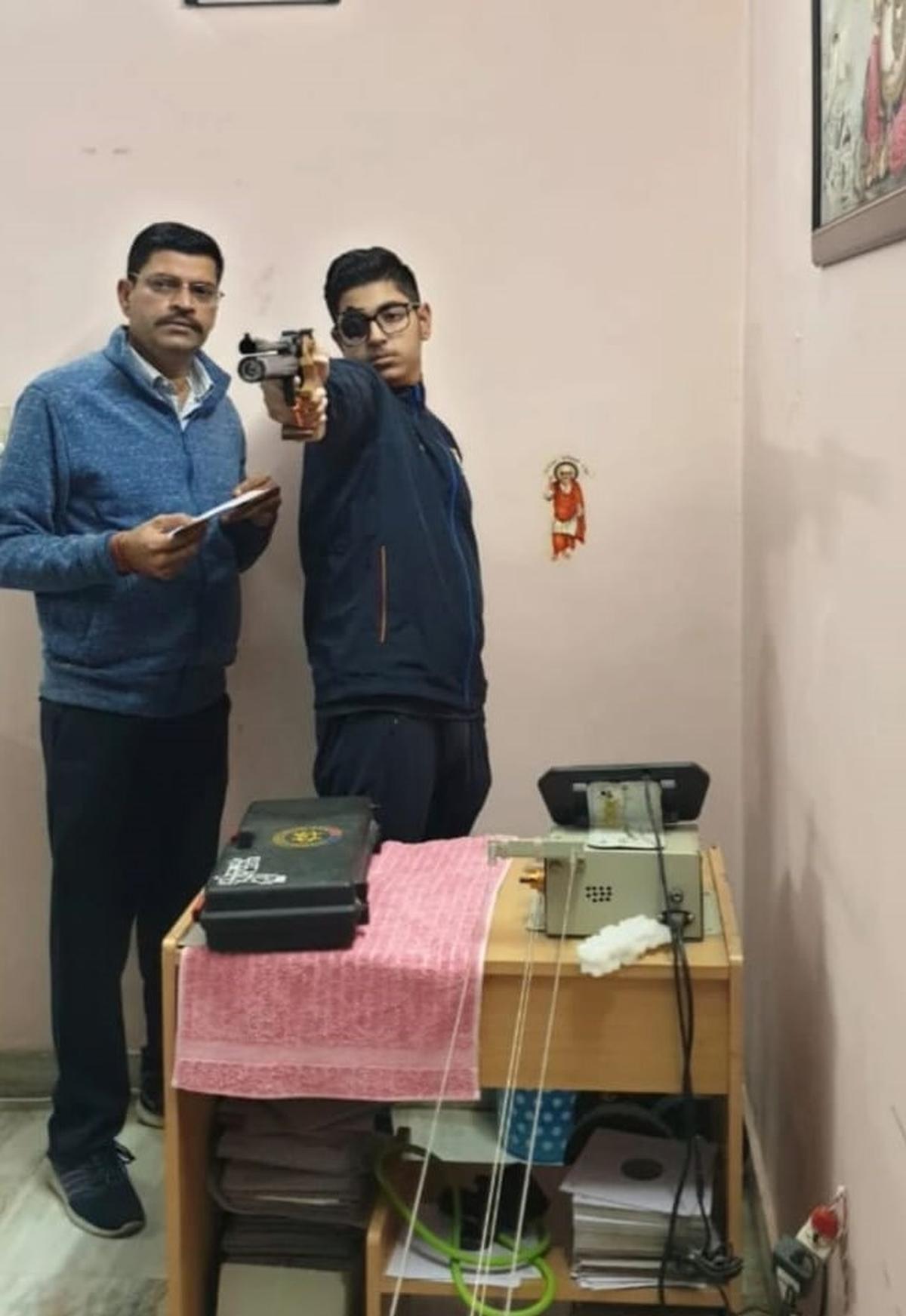Samrat Rana goes from homemade range to top of World Championships podium
Ashok Rana got more than a few concerned looks when he decided to build a makeshift pistol shooting range in his Karnal home in 2017. The setup was rudimentary, to say the least. “I got a paper target mounted on the front of a wooden box that I padded with cloth to catch any pellets. Then I measured 10 metres from the target and drew a line. I also wired a digital camera to record the target so you could see what you had shot. After that, I bought an air pistol, gave it to my son Samrat, who was 12 years old, and told him to shoot,” Ashok tells Sportstar.
The entire scheme had to be kept hidden, he says — not least because the setup was in a rented accommodation.
There was nothing to hide and everything to celebrate on Monday night.
Samrat Rana’s shooting journey may have had humble beginnings, but on Monday evening, it took him to the top of the podium at the ISSF World Championships in Cairo, where he became the first Indian to win gold in the men’s 10m air pistol competition.
He had to display nerves of steel to secure his historic title.
Going into the last shot of the competition, few would have been willing to write off China’s Hu Kai, even though he had to make up a deficit. The Chinese shooter had been in red-hot form this season, having won the 10m air pistol gold at all four World Cups as well as at the Asian Championships.
At the World Championships final, he found a worthy rival in Samrat. The two traded the lead all through the contest. It was surprising that Samrat managed to stay that close. The 20-year-old was competing at his maiden World Championships and didn’t have anything like Kai’s resume. Earlier this year, he had competed at just one World Cup, in Ningbo, where he finished 10th in qualification.
Just finishing with a medal ahead of a field that included the podium finishers of the 2024 Olympics — Xie Yu, Federico Maldini and Paolo Monna — was impressive enough. But Samrat wasn’t done.
Hu held a narrow 0.1-point lead going into the final series of two shots that would decide the winner. A poor 9.5 to the Indian’s 10.2 gave Samrat a 0.6-point lead with one shot to go. Hu responded with a near-perfect 10.8, which meant Samrat needed a 10.3 or higher to seal gold. Over his 23 shots so far, Samrat had crossed that mark only six times.
ALSO READ | ISSF World Championships: Varun takes bronze in 10m air pistol; no medals for Manu and Esha
There would be no late drama. Displaying ice in his veins, Samrat calmly squeezed off a 10.6 and, with a smile, allowed himself a fist bump. He had beaten Hu 243.7 to 243.3.
Vindication of coaching methods
If the gold was an official stamp of Samrat’s class, it was also vindication of Ashok’s undeniably unusual training practices — a method born of his own early experiments with shooting.
Growing up, Ashok says he always wanted to be a shooter. “I was obsessed with shooting. I started with a gulel (catapult). Then I started shooting with an air gun. Later, I started practising with my older brother’s licensed rifle,” he says. But for all his obsession, Ashok, who grew up in Uplana, didn’t have any pathway to formal sport shooting. “Back in the 1990s, there was no idea in the villages of what Olympic shooting actually was. I used to practise all sorts of things. I would practise shooting against running targets or against targets 400 to 500 metres away. I took apart and put together guns. But none of that was actually what target shooting was. By the time I actually found out about Olympic shooting, I had already gone past the age where I could be a shooter,” he says.
Ashok got married and had four children — the youngest of whom was Samrat.
In 2015, the family moved from the village to the district capital of Karnal, ostensibly for better educational opportunities for the children. There, Ashok’s passion for shooting was reignited.
“In Karnal I started seeing a lot of shooting ranges. I realised that there were all these facilities available. I went inside them and realised I could do this for my children. If I couldn’t become a shooter, I would take all my passion and make at least one of my children one,” he recalls.
Makeshift range
It wasn’t too hard to build his first makeshift range, he recalls. “I’d been a foreman on the wheat combine harvester before, so I’ve always had a technical mind. It wasn’t difficult for me to fix a digital scoring system using cameras and paper targets,” he says. The bigger challenge was learning how to coach his children — but Ashok says he read extensively and relied on his own shooting experience.
Of his children, Samrat was the most talented. After a year of training at home, Ashok took him to a range to provide what he couldn’t. “I was confident about teaching Samrat to shoot, but I didn’t have any idea about the paperwork needed to compete at State and national level. I admitted Samrat to an academy just for that purpose,” he says.

If the gold was an official stamp of Samrat’s class, it was also vindication of his father Ashok’s undeniably unusual training practices — a method born of his own early experiments with shooting.
| Photo Credit:
SPECIAL ARRANGEMENT
If the gold was an official stamp of Samrat’s class, it was also vindication of his father Ashok’s undeniably unusual training practices — a method born of his own early experiments with shooting.
| Photo Credit:
SPECIAL ARRANGEMENT
Within a couple of years, Samrat was competing at the national level. At 17, he made his India debut at the Junior World Championships in Cairo, winning gold in both the men’s and mixed team events.
Even as the results came at national and international levels, Samrat continued to train with his father. By this time, they had shifted out of their rented accommodation to a house Ashok had built in Karnal — complete with a basement specifically designed for pistol shooting.
“After winning the Khelo India Youth Games in 2022, he had the chance to go and train in Delhi. But he prefers to train with me only,” says Ashok. He admits his training methods are unorthodox but insists they work.
“The biggest challenge in shooting is how to deal with pressure. There’s no escaping it, but you have to learn to shoot with it. I prepare Samrat by making him compete in all sorts of scenarios. Sometimes, I will make him do a long run and then shoot when his heart rate is high. At other times, I’ll wake him up from sleep and have him shoot then, when he’s tired. That way, very little feels unusual to him. Sometimes I feel I’m being a haanikarak baapu (tough father), but I think my methods work. He can be competing against the strongest player in the world, but for him it’s nothing,” says Ashok.
For all the challenges Ashok puts Samrat through in practice, he says he doesn’t apply the same pressure during competition. “During matches, you won’t see me running behind Samrat. I have always been clear that he needs to solve whatever problems he faces during a match. At the same time, I don’t tell him he needs to win gold or anything. My only expectation is that he shoots as well as he can in qualification. The final will take care of itself. Aaj nahi toh kal ayega. Kal nahi toh parso aa jayega (If it doesn’t come today, it will come tomorrow. If not tomorrow, then the day after),” says Ashok.
Bigger targets
Even though Samrat didn’t have a senior medal to show this year, Ashok says he wasn’t worried heading into the World Championships. “I told Samrat that even if he didn’t win a gold, I wouldn’t have had a problem. As long as he shoots consistently in qualification, I’m satisfied,” he says.
Samrat did exactly that — qualifying in first place with a score of 586, before putting together a near-perfect finals performance. Gold secured, Samrat spoke to his father, who reminded him his job wasn’t done yet. “It’s good that he won a gold in the individual (and also the men’s team event). But he has a mixed team event as well and needs to prepare for that,” Ashok says.
There’s another major goal, too. “It’s very good that he’s won a World Championships gold, but the medal every shooter wants is the Olympic medal. We have three years for that competition, and that’s our target. Our journey isn’t complete till we win that medal,” says Ashok.
Published on Nov 11, 2025



